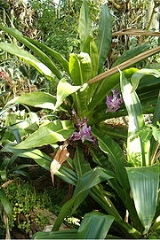
Cochliostema
Encyclopedia
Cochliostema is a genus of plants with two species in the family Commelinaceae
(the spiderwort and dayflower family). The genus occurs from southern Nicaragua
to southern Ecuador
.
, followed by Geogenanthus
. All three genera share the possession of flower petals fringed with moniliform trichomes. Within Cochliostema there are two species: Cochliostema velutinum R.W.Read and Cochliostema odoratissimum Lemaire. Cochliostema jacobianum, a 19th century name thought to represent another species and still popular among horticulturists, is considered as part of the latter species.
, typically unbranched herbs with somewhat succulent, strap-shaped leaves. In the wild, plants grow as epiphytes; however, terrestrial plants are found on or around tree falls suggesting that these ground-dwelling plants had been growing epiphytically. One species, Cochliostema odoratissimum, is a tank-epiphyte, resembling certain bromeliads in this respect. This species also attains the greatest size for the genus, with its leaves reaching to 1 m in length, and plants sometimes reaching 2 m in height.
Flower
s are borne in large thyrses and are generally the largest (ca. 2.5 cm diam.), among the most fragrant, and arguably the most complex in the spiderwort family. They consist of 3 sepal
s, 3 blue to blue-violet and fringed petal
s, 3 stamens fused by their filaments in the upper half of the flower, and 3 carpels fused into a single trilocular pistil. The fused stamina
l structure has 3 spirally coiled anthers enveloped and concealed by petaloid extensions of the filaments of the two lateral stamens contributing to the 3-staminate structure. These structures, termed "cuculli", are narrowed into two distal hose-like extensions.
Commelinaceae
Commelinaceae is a family of flowering plants. In less formal contexts, the group is referred to as the dayflower family or spiderwort family. It is one of five families in the order Commelinales and by far the largest of these with an estimated 650 species in 40 genera. Well known genera include...
(the spiderwort and dayflower family). The genus occurs from southern Nicaragua
Nicaragua
Nicaragua is the largest country in the Central American American isthmus, bordered by Honduras to the north and Costa Rica to the south. The country is situated between 11 and 14 degrees north of the Equator in the Northern Hemisphere, which places it entirely within the tropics. The Pacific Ocean...
to southern Ecuador
Ecuador
Ecuador , officially the Republic of Ecuador is a representative democratic republic in South America, bordered by Colombia on the north, Peru on the east and south, and by the Pacific Ocean to the west. It is one of only two countries in South America, along with Chile, that do not have a border...
.
Systematics
Cochliostema is a member of the subtribe Dichorisandrinae of the tribe Tradescantieae of the flowering plant family Commelinaceae. Its closest relative in the Dichorisandrinae is PlowmanianthusPlowmanianthus
Plowmanianthus Faden & C.R.Hardy is a genus of plants with 5 species and 2 subspecies in the family Commelinaceae . The genus is distributed from Panama to Amazonian Peru and Brazil.-Systematics:...
, followed by Geogenanthus
Geogenanthus
Geogenanthus is a genus of plants with 3 species in the family Commelinaceae . The genus is distributed from Colombia to Amazonian Peru and Brazil...
. All three genera share the possession of flower petals fringed with moniliform trichomes. Within Cochliostema there are two species: Cochliostema velutinum R.W.Read and Cochliostema odoratissimum Lemaire. Cochliostema jacobianum, a 19th century name thought to represent another species and still popular among horticulturists, is considered as part of the latter species.
Morphology
RosetteRosette (botany)
In botany, a rosette is a circular arrangement of leaves, with all the leaves at a single height.Though rosettes usually sit near the soil, their structure is an example of a modified stem.-Function:...
, typically unbranched herbs with somewhat succulent, strap-shaped leaves. In the wild, plants grow as epiphytes; however, terrestrial plants are found on or around tree falls suggesting that these ground-dwelling plants had been growing epiphytically. One species, Cochliostema odoratissimum, is a tank-epiphyte, resembling certain bromeliads in this respect. This species also attains the greatest size for the genus, with its leaves reaching to 1 m in length, and plants sometimes reaching 2 m in height.
Flower
Flower
A flower, sometimes known as a bloom or blossom, is the reproductive structure found in flowering plants . The biological function of a flower is to effect reproduction, usually by providing a mechanism for the union of sperm with eggs...
s are borne in large thyrses and are generally the largest (ca. 2.5 cm diam.), among the most fragrant, and arguably the most complex in the spiderwort family. They consist of 3 sepal
Sepal
A sepal is a part of the flower of angiosperms . Collectively the sepals form the calyx, which is the outermost whorl of parts that form a flower. Usually green, sepals have the typical function of protecting the petals when the flower is in bud...
s, 3 blue to blue-violet and fringed petal
Petal
Petals are modified leaves that surround the reproductive parts of flowers. They often are brightly colored or unusually shaped to attract pollinators. Together, all of the petals of a flower are called a corolla. Petals are usually accompanied by another set of special leaves called sepals lying...
s, 3 stamens fused by their filaments in the upper half of the flower, and 3 carpels fused into a single trilocular pistil. The fused stamina
Endurance
Endurance is the ability for a human or animal to exert itself and remain active for a long period of time, as well as its ability to resist, withstand, recover from, and have immunity to trauma, wounds, or fatigue. In humans, it is usually used in aerobic or anaerobic exercise...
l structure has 3 spirally coiled anthers enveloped and concealed by petaloid extensions of the filaments of the two lateral stamens contributing to the 3-staminate structure. These structures, termed "cuculli", are narrowed into two distal hose-like extensions.

